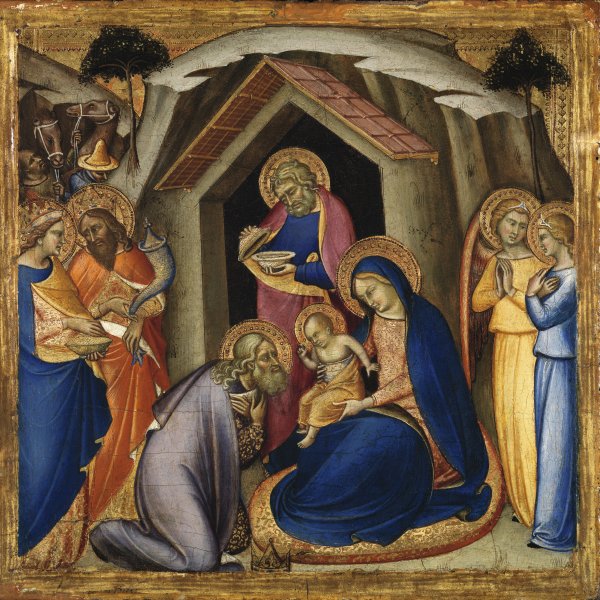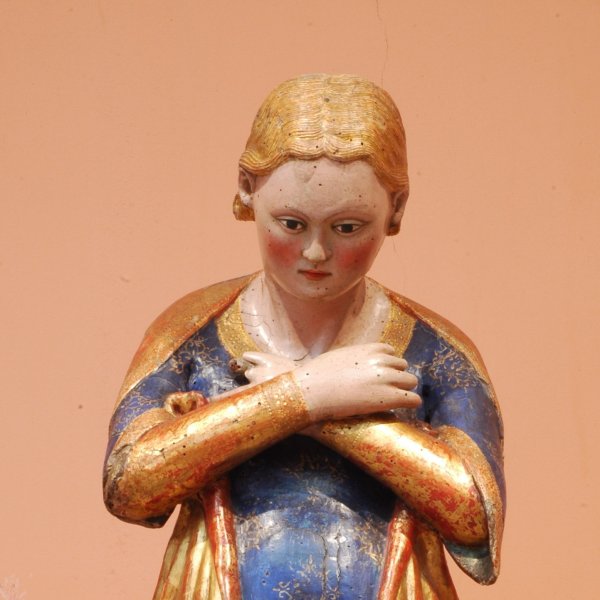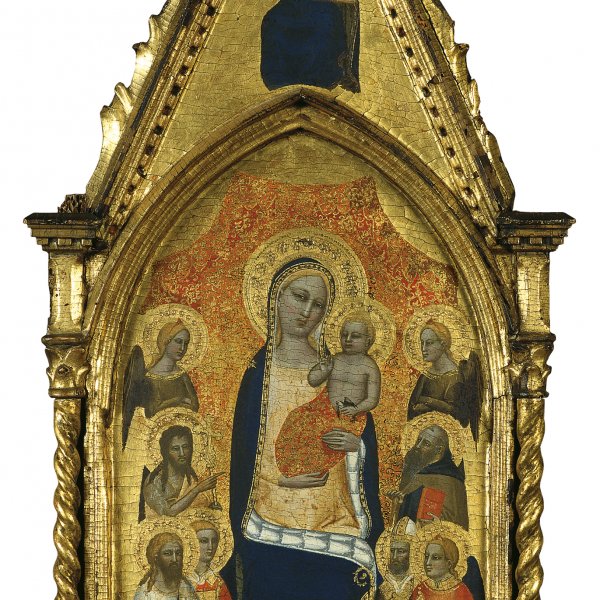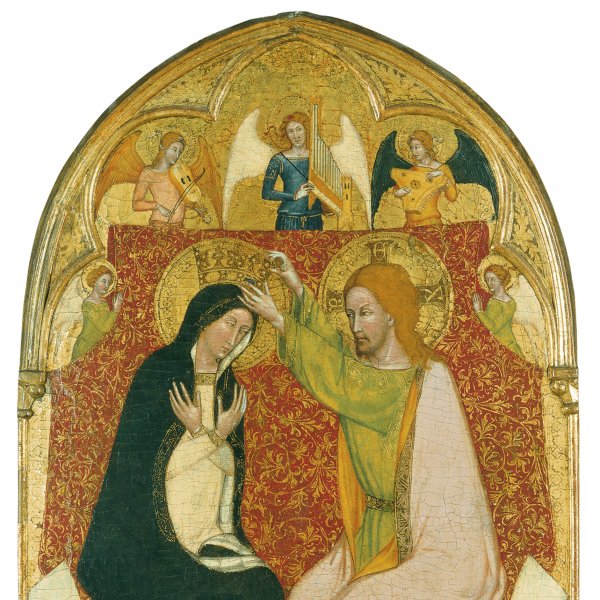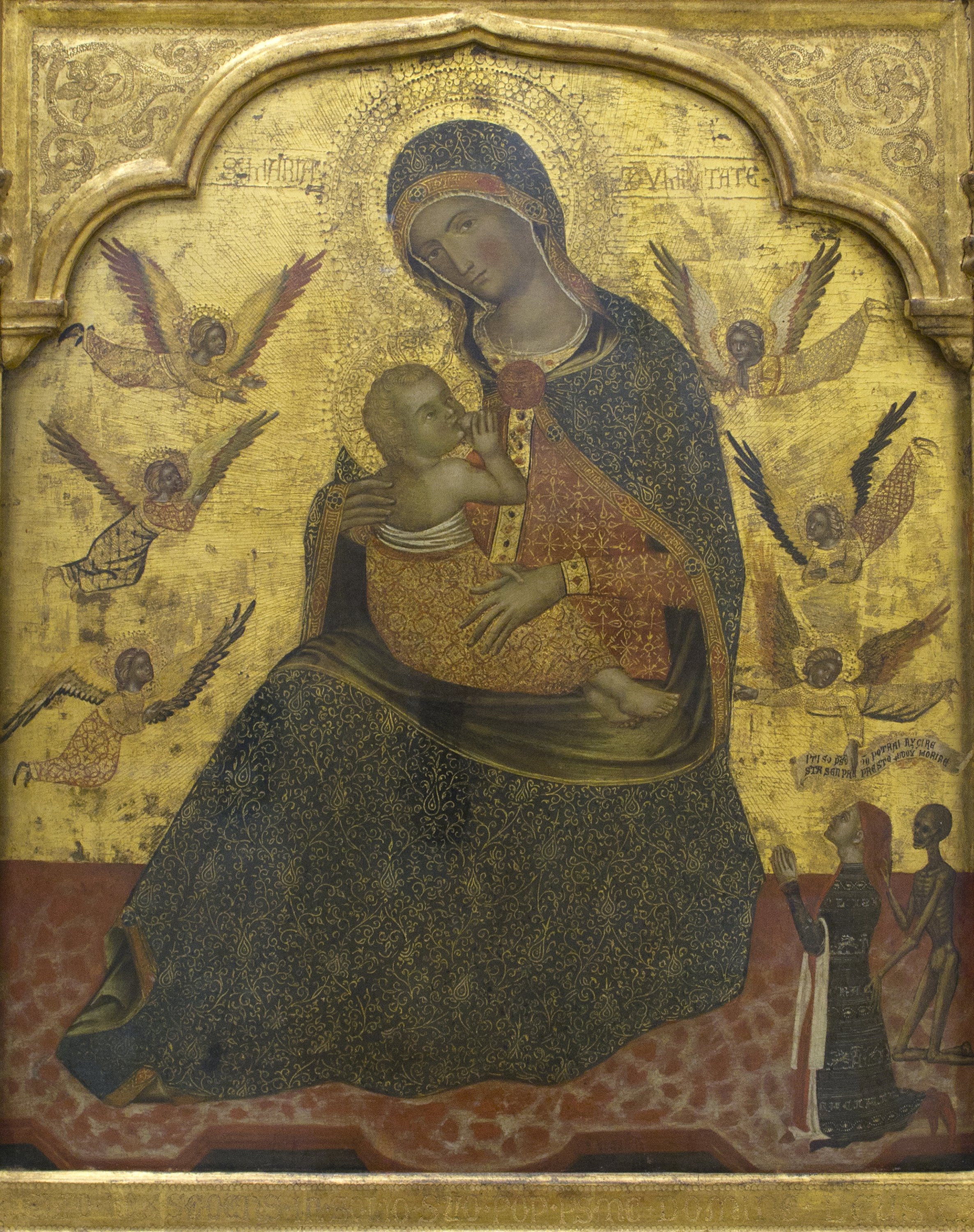The Virgin of Humility with Angels and a Donor
ca. 1360
Tempera and gold on panel.
68.8 x 56.7 cm
Museo Nacional Thyssen-Bornemisza, Madrid
Inv. no.
257
(1930.59
)
Room 1
Level 2
Permanent Collection
This Virgin of Humility, whose title is inscribed on the gold background of the panel, was possibly acquired a few months before the 1930 Munich exhibition of works from the Collection. This
suggestion, made by Boskovits, is based on the existence of two reports by Raimond van Marle and Georg Gronau written prior to the exhibition’s opening and probably prior to the acquisition of the panel. The painting was first shown to the public and to art historians at the exhibition, and the first published reference to this work is to be found in an article on the exhibition published by E. Hanfstaengl in Art News. With regard to its earlier history, it is known that it was in a private collection in Paderborn and that it was on the art market in the early part of 1930.
Since the Munich exhibition numerous efforts have been made to determine the attribution, so far without success. Raimond van Marle attributed to it to Paolo Veneziano, while Gronau opted for Lorenzo Veneziano. Other art historians partly accepted Van Marle’s suggestion, including Pallucchini, who in 1964 identified a new master whom he called the Master of Memento Mori after the inscription on the present panel and whom he connected with a Virgin of Humility in the Pushkin Museum in Moscow and another Virgin in the Galleria Tadini in Lovere. According to Pallucchini, this new artist trained in the circle of Paolo Veneziano and knew the work of Stefano di Sant’Agnese, as can be seen in the Lovere panel. Palluchini’s attribution was adopted by Caroline de Watteville in her 1989 catalogue of the Thyssen-Bornemisza collection. The current attribution, however, was made by Boskovits, who made a detailed analysis of the work in which he considered all the various suggestions proposed but ultimately opted to leave the panel as a work by an anonymous Venetian artist.
Erwin Panofsky was interested in the panel’s iconography and he included it in an article on the figure of death in Christian art and literature. One of the most interesting aspects of this panel is undoubtedly the iconography of the figures in the lower right corner, depicted on a much smaller scale than the central group, in the traditional manner. The artist depicts a richly dressed donor, kneeling in prayer and looking up at the Virgin. He is pushed forward from behind by a skeleton, also kneeling. This scene is completed by the figure of an angel above the group who points to the Virgin and Child while holding in its other hand a banderole with a text that reminds us of the inevitability of death. The melancholy aspect of the image, which is forcefully expressed in a way similar to other compositions of this type, is mitigated here by the redeeming presence of the Virgin and Christ Child and by the pious mood of the composition as a whole. Panofsky noted how death, symbolised by the skeleton, “tenderly recommends the donor be admitted to heaven”.
This Virgin of Humility follows the traditional iconography in which the Virgin is depicted seated and breastfeeding the Child, although in this case she is sitting on a marble platform rather than on the ground. Surrounded by small angels in attitudes of devotion, her form is precisely outlined against the gold background. The artist was not, however, able to convey the volumes of the figures in a totally successful manner, and their elegant bodies are concealed beneath the splendid, ample draperies with their finely worked decoration.
This panel has a particular significance in that it contains the earliest portrait in the Museo Thyssen-Bornemisza, a genre fully and continuously represented in the Collection from the 14th to the 20th centuries.
Mar Borobia
Since the Munich exhibition numerous efforts have been made to determine the attribution, so far without success. Raimond van Marle attributed to it to Paolo Veneziano, while Gronau opted for Lorenzo Veneziano. Other art historians partly accepted Van Marle’s suggestion, including Pallucchini, who in 1964 identified a new master whom he called the Master of Memento Mori after the inscription on the present panel and whom he connected with a Virgin of Humility in the Pushkin Museum in Moscow and another Virgin in the Galleria Tadini in Lovere. According to Pallucchini, this new artist trained in the circle of Paolo Veneziano and knew the work of Stefano di Sant’Agnese, as can be seen in the Lovere panel. Palluchini’s attribution was adopted by Caroline de Watteville in her 1989 catalogue of the Thyssen-Bornemisza collection. The current attribution, however, was made by Boskovits, who made a detailed analysis of the work in which he considered all the various suggestions proposed but ultimately opted to leave the panel as a work by an anonymous Venetian artist.
Erwin Panofsky was interested in the panel’s iconography and he included it in an article on the figure of death in Christian art and literature. One of the most interesting aspects of this panel is undoubtedly the iconography of the figures in the lower right corner, depicted on a much smaller scale than the central group, in the traditional manner. The artist depicts a richly dressed donor, kneeling in prayer and looking up at the Virgin. He is pushed forward from behind by a skeleton, also kneeling. This scene is completed by the figure of an angel above the group who points to the Virgin and Child while holding in its other hand a banderole with a text that reminds us of the inevitability of death. The melancholy aspect of the image, which is forcefully expressed in a way similar to other compositions of this type, is mitigated here by the redeeming presence of the Virgin and Christ Child and by the pious mood of the composition as a whole. Panofsky noted how death, symbolised by the skeleton, “tenderly recommends the donor be admitted to heaven”.
This Virgin of Humility follows the traditional iconography in which the Virgin is depicted seated and breastfeeding the Child, although in this case she is sitting on a marble platform rather than on the ground. Surrounded by small angels in attitudes of devotion, her form is precisely outlined against the gold background. The artist was not, however, able to convey the volumes of the figures in a totally successful manner, and their elegant bodies are concealed beneath the splendid, ample draperies with their finely worked decoration.
This panel has a particular significance in that it contains the earliest portrait in the Museo Thyssen-Bornemisza, a genre fully and continuously represented in the Collection from the 14th to the 20th centuries.
Mar Borobia





